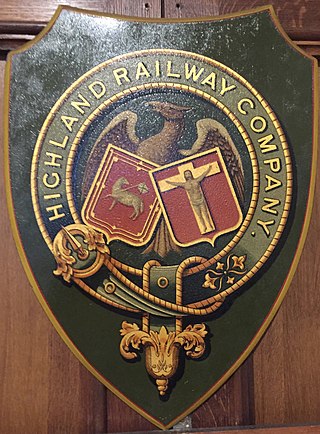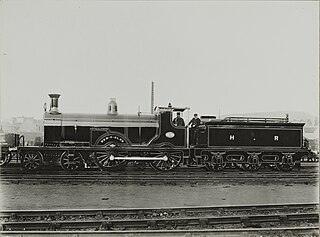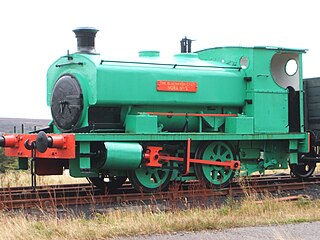Related Research Articles

The Highland Railway (HR) was one of the smaller British railways before the Railways Act 1921, operating north of Perth railway station in Scotland and serving the farthest north of Britain. Based in Inverness, the company was formed by merger in 1865, absorbing over 249 miles (401 km) of line. It continued to expand, reaching Wick and Thurso in the north and Kyle of Lochalsh in the west, eventually serving the counties of Caithness, Sutherland, Ross & Cromarty, Inverness, Perth, Nairn, Moray and Banff. Southward it connected with the Caledonian Railway at Stanley Junction, north of Perth, and eastward with the Great North of Scotland Railway at Boat of Garten, Elgin, Keith and Portessie.

The Highland Railway's Clan Goods class was a class of steam locomotive. They were designed by Christopher Cumming. The first four were built by Hawthorn Leslie and Company on Tyneside, and the maker's plates bore the date 1917, but because of wartime delays were not delivered until 1918. Four more were built in 1919, also by Hawthorn Leslie.

The Highland Railway Ben Class were small 4-4-0 passenger steam locomotives. There were actually two separate 'Ben' classes, usually referred to as the 'Small Bens' and the 'Large Bens'.
The Highland Railway began as the Inverness and Nairn Railway, which operated the other lines which became part of the Highland Railway on its formation in 1865. For post-1870 locomotives, see Locomotives of the Highland Railway.
The Highland Railway E Class was a class of 4-4-0 steam locomotive designed by David Jones for passenger service. They were also known as the 'Clyde Bogies' as they were built by the Clyde Locomotive Company in Glasgow, Scotland. They were the first locomotives built by that company.
The Highland Railway P class was a group of five 4-4-0T steam locomotives built in 1891 and 1893 by Dübs and Company of Glasgow.
The Highland Railway Strath Class were 4-4-0 steam locomotives introduced in 1892, to the design of David Jones.

The Highland Railway Jones Goods class was a class of steam locomotive, and was notable as the first class with a 4-6-0 wheel arrangement in the British Isles. Fifteen were built, and one has survived to preservation. Originally known as the Big Goods class, they became class I under Peter Drummond's 1901 classification scheme.
The Highland Railway W class were four small 0-4-4T locomotives built by the Highland Railway in 1905–1906 to the design of locomotive superintendent Peter Drummond. They were the last engines that were built at the company's Lochgorm works in Inverness, and were used on branch line services.

Sharp, Stewart and Company was a steam locomotive manufacturer, initially located in Manchester, England. The company was formed in 1843 upon the demise of Sharp, Roberts & Co.. It moved to Glasgow, Scotland, in 1888, eventually amalgamating with two other Glaswegian locomotive manufacturers to form the North British Locomotive Company.

Neilson and Company was a locomotive manufacturer in Glasgow, Scotland.
The Glasgow and Renfrew District Railway was nominally owned by the Glasgow and Paisley Joint Railway. It was incorporated on 6 August 1897 and opened on 1 June 1903.

The Dornoch Light Railway was a branch railway in Scotland that ran from The Mound on the Far North Line to Dornoch, the county town of Sutherland.
Fredrick George Smith was a British mechanical engineer. He was born in Newcastle upon Tyne in 1872 and died in 1956. He was appointed manager of the Highland Railway's Lochgorm Works in 1903, and promoted to Assistant to the Chief Mechanical Engineer, Peter Drummond in 1903.

The Midland Railway 1252 class was a class of thirty 0-4-4T locomotives built by Neilson and Company in 1875–1876 to the design of Samuel Waite Johnson. They were a development of the 6 Class. Originally numbers 1262–1281 and 1252–1261. Under the Midland Railway's 1907 renumbering scheme they became 1236–1265.
James Stirling (1835–1917) was a Scottish mechanical engineer. He was Locomotive Superintendent of the Glasgow and South Western Railway and later the South Eastern Railway. Stirling was born on 2 October 1835, a son of Robert Stirling, rector of Galston, East Ayrshire.

'Pug' locomotives are small steam locomotives which were produced for light shunting work, usually at dockyards, factory sites, steelworks, collieries, and other similar locations. The name is derived from a common term in Scotland for a small industrial shunting engine, typically an 0-4-0 tank.
The Glasgow and South Western Railway (GSWR) 23 class is a class of twenty 0-4-2 steam locomotives designed in 1860. They were by Patrick Stirling's fourth 0-4-2 design for the railway.
Events from the year 1831 in Scotland.
References
- Awdry, Christopher (1990). Encyclopaedia of British Railway Companies. London: Guild Publishing. CN 8983.
- Baxter, Bertram (1984). Baxter, David (ed.). Volume 4: Scottish and remaining English Companies in the LMS Group. British Locomotive Catalogue 1825-1923. Ashbourne: Moorland Publishing.
- Cooke, B.W.C., ed. (December 1964). "The Why and the Wherefore: Two Glasgow locomotive builders". Railway Magazine . Vol. 110, no. 764. Westminster: Tothill Press.
- Cormack, J.R.H.; Stevenson, J.L. (1988). Greenwood, William (ed.). Highland Railway Locomotives Book 1: Early Days to the 'Lochs'. Locomotives of the LMS. Lincoln: RCTS. ISBN 0-901115-64-9.
- Lowe, James W. (1989) [1975]. British Steam Locomotive Builders. Guild Publishing. CN8274.
- Marshall, John (1978). A Biographical Dictionary of Railway Engineers. Newton Abbot: David & Charles. ISBN 0-7153-7489-3.